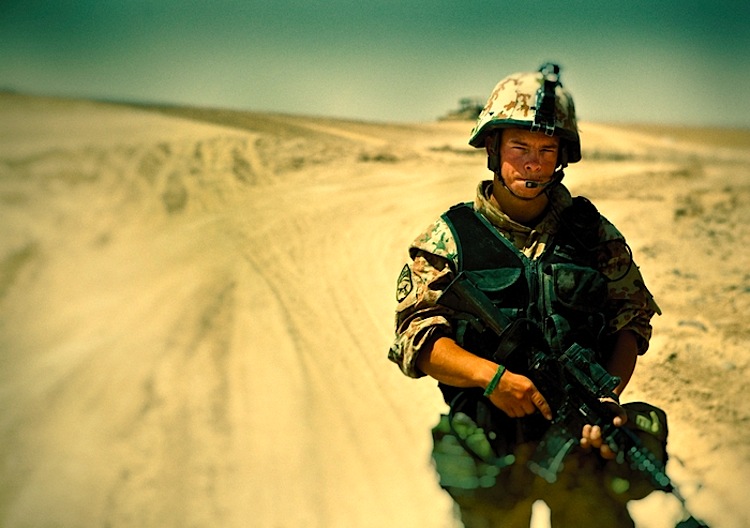By Joe Bendel. Just because they are Danish soldiers, that does not mean they should trust the media any more than their American counterparts. A group of Danes serving in Afghanistan learns this PR lesson the hard way in Janus Metz’s embed-style documentary Armadillo, which opened yesterday in New York and elsewhere.
Amazingly, as the film opens, the Danish unit stationed at the Helmand forward operating base (nicknamed Armadillo) has yet to suffer a fatal casualty. In fact, when the group of soldiers Metz follows from enlistment and basic training arrive at Armadillo, boredom seems to be their greatest foe. In a rather clumsy effort to be provocative, Metz makes much of their choice of entertainment: violent video games and run-of-the-mill porn, as if this were shocking for a group of twenty-something men serving in the middle of nowhere without any interaction with women.
The Danish soldiers make an effort to reach out to the locals, but they have trouble overcoming the widespread fear of Taliban reprisals. Isolated and untested, the Helmand outpost is simply too tempting a target for the Taliban to resist for long. Eventually they make their move. Unfortunately, it is impossible to really tell what went down in the soon-to-be-controversial incident. Most of the camerawork is a veritable blur, which is understandable considering that bullets were flying. However, Metz never establishes any reference points for area in question, or sets the scene in any way.
From what we can glean from the film, the Danish soldiers were able to pin down a group of Taliban guerillas in a ravine not far from Armadillo. Unable to tell how many men were concealed there or in what condition, they lobbed over a few grenades until it seemed safely quiet. Surviving a real life firefight in which members of their unit sustained serious but not critical injuries, the men were understandably satisfied with the outcome.
However, it seems one of the Danish soldiers (as yet unidentified), leaked word to the media that his brothers-in-arms had “liquidated” injured Taliban and bragged about it afterward. None of this is in the film. Nevertheless, some in Denmark expressed outrage that the soldiers celebrated their success in combat. Particularly vexing were statements to the effect that the Taliban deserved to die.
Here is a reality check: the Danish soldiers were correct. The Taliban terrorize their own people – enforcing a misogynistic, homophobic doctrine of hate. They themselves adhere to no civilized rules of engagement. What the Danes did was not a crime. It is what we call a ‘result.’ Yet, by milking the firestorm in the Danish press (which reaches Armadillo at just under light speed), Metz essentially tips his hand. He cannot prove it with his footage, but the implied narrative is that the Danish soldiers are thrill junkies, out for a spot of bloodsport.
The great irony is that the subjects themselves largely undercut the meta-message. Yes, they are grunts. Col. Jessup would certainly approve. Yet, they do reach out to the Afghan people and exhibit loyalty to each other (albeit with one significant exception). The final kicker of the film is the where-are-they-now scroll, in which nearly every one of the Armadillo men has either re-enlisted with the intent of returning to Afghanistan, or is seriously considering it. Metz never asks why, but one can guess it involves duty, honor, and a sense of unfinished business.
Clearly the men of Armadillo never relax and open up around Metz like the Army Airborne soldiers Hetherington and Junger documented in Restrepo. As a result, it never packs the same emotional punch. While there are some insights to be gleaned into modern military realities, especially the confrontational nature of the media, one suspects Armadillo fails by its own standards. If nothing else, it serves as a timely reminder of our Danish friends and allies’ continuing service in Afghanistan. Flawed but still somewhat interesting, Armadillo opened Friday (4/15) in New York at the IFC Center.
Posted on April 16th, 2011 at 11:31am.

The telling detail here is that these Danish soldiers would choose to re-enlist and be sent back, despite the biased reporting of this embedded “journalist.” With journalists like this going in with obvious agendas to try to discredit troops fighting in these wars, has embedding reporters really worked out?